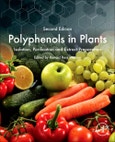Polyphenols in Plants: Isolation, Purification and Extract Preparation, 2nd edition, provides a detailed insight into polyphenols that occur naturally in plants and how they can be affected during growth and development, then effectively removed and optimized for various applications in food production. Historically, plants have been the major sources for drugs and health promotion. While there are a small number of nutrients contained, the growing focus is on the very diverse, complex ring structures: polyphenols that are not nutritious. In order to study or use them in patient treatment, the polyphenols need to be isolated, identified, and purified for application and study. This book brings together experts in the field who share their ongoing examination of isolation and purification of polyphenols as well as determination of their structures and composition.
Polyphenols in Plants covers a range of new topics including polyphenols in vegetable waste and agricultural byproducts, extraction methods and characterization of polyphenols, and isolation techniques in the development of new compounds and their use in cancer therapy. This book will be useful to plant scientists and dietary supplement producers, as well as scientists in the food industry and alternative medicine who are interested in the specific health benefits of various dietary extracts and other polyphenol resources.
Please Note: This is an On Demand product, delivery may take up to 11 working days after payment has been received.
Table of Contents
Section 1: Modification by Plant Growth and Environment 1. Not only what is food is good polyphenols from edible and non-edible vegetable waste 2. Polyphenols in agricultural by-products and food waste 3. Phenolic natural compounds and their influence on physiological processes in plants 4. Improving bioavailability of polyphenols using nano-delivery systems based on food polymers 5. Plant phenolics in foods
Section 2: Isolation and Analysis of Polyphenol Structure 6. Structure and antioxidant efficiency of beech (Fagus sylvatica L.) bark polyphenols unravelled by high-performance liquid chromatography/photodiode array detection/multistage electrospray mass spectrometry and chemometrics 7. Characterization and Quantification of Polyphenols in Fruits 8. Phenotypic diversity of colored phytochemicals in sorghum accessions with various pericarp pigments 9. Relevance and analysis of citrus flavonoids 10. Extraction methods of polyphenol from grapes 11. Total polyphenols content and antioxidant DPPH assays on biological samples 12. Extraction phenolic compounds from Coriandrum sativum L. and Amaranthus hybridus L. by microwave technology 13. Curcumin/turmeric as an environment-friendly stain for proteins on acrylamide gels 14. Anthocyanins and other polyphenols in citrus genus: Biosynthesis, chemical profile, and biological activity 15. Rice phenolics: extraction, characterization and utilization in foods
Section 3: Analysis Techniques for Polyphenols 16. Gas chromatography mass spectrometry analysis of polyphenols in foods 17. Reaction of Hemoglobin with the Schiff base intermediate of the Glucose/Asparagine reaction: Formation of a Hemichrome 18. Adsorption and ion exchange for the recovery and fractionation of polyphenols Principles and applications 19. Flavonoids from Holarrhena floribunda (G.don) leaves 20. HILIC chromatography- Powerful technique in the analysis of polyphenols 21. Chromatographic analysis of polyphenols 22. Preparative purification of polyphenols from sweet potato (Ipomoea batatas L.) leaves by AB-8 macroporous resin 23. Evaluation of the phytochemistry and biological activity of grape (Vitis vinifera L.) stems: towards a sustainable winery industry 24. The phenolic gingerols and gingerol-derived shogaols: features and properties related to the prevention and treatment of cancer and chronic inflammation 25. Polyphenols presents in campomanesia genus: Pharmacological and nutraceutical approach








